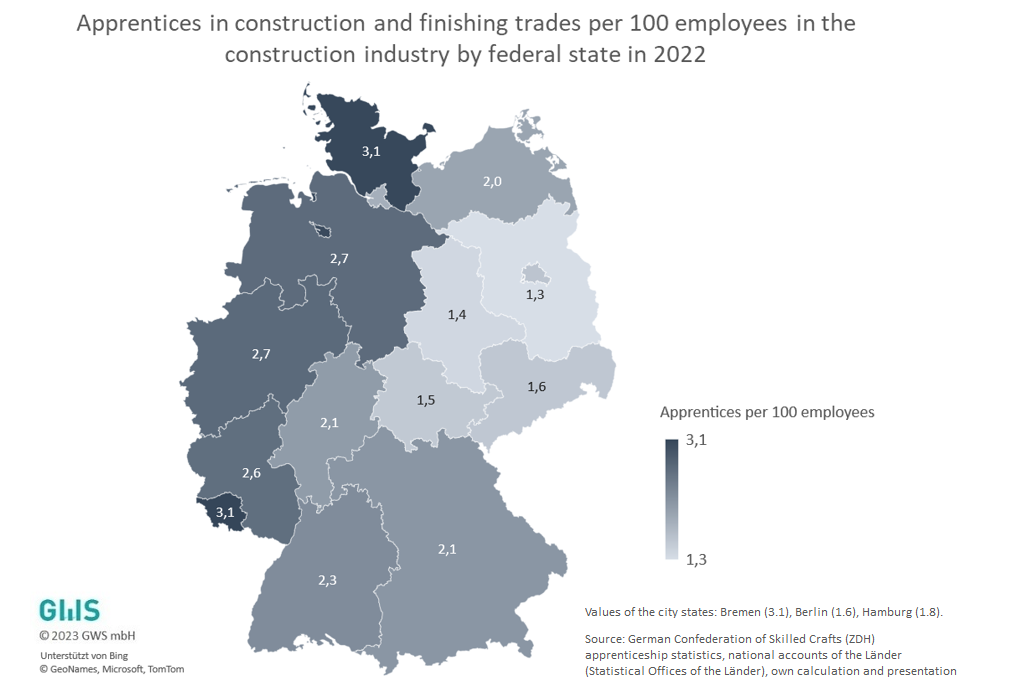Young talent for the construction industry – a look at apprenticeship figures in the construction and finishing trades
Our figure of the month 10/2023
The construction industry is currently caught between slumping order numbers due to high construction and financing costs and the German government's goal of building 400,000 homes a year. In addition, the finishing trade in particular plays a decisive role in the successful achievement of the climate line. As a result, even in times of cooling construction activity, a large proportion of companies are planning to maintain their workforce levels, and the issue of a shortage of skilled workers continues to affect many companies' operations.
Our October figure of the month deals with the question of how well the construction industry is equipped to deal with the shortage of skilled workers in the future. The current ratio of employees to apprentices can provide an indicator of this. If the ratio is 2.5, employees in the sector would have to work for an average of around 40 years to keep the number of employees constant in the future. If the ratio is lower, it would theoretically be necessary to work longer in order to keep the number of employees constant; if it is higher, it would theoretically be possible to work shorter hours.
In the following, we will first look at the development of the number of people in employment in the construction industry before turning our attention to the number of apprentices in the construction and finishing trades. Finally, we will calculate and present the ratio of apprentices per 100 employees at both the national and state level.
If we look at the nationwide development of employment figures in the construction industry in recent years, the initial picture is positive. An evaluation of the national accounts of the federal states (VGRdL) showed growth at the federal level of around 9.7% for the period from 2012 to 2022. In 2012, around 2.4 million people were employed in the construction sector, rising to around 2.63 million in 2022. At the level of the federal states, the development was mixed. While Schleswig-Holstein (+20.6%), Hesse (+18.8%) and Baden-Württemberg (+15.6%), for example, recorded high percentage increases in the period under review, the development of the number of people employed in the construction industry declined in Saxony (-4.6%), Saxony-Anhalt (-8.3%) and Thuringia (-14.3%).
An analysis of the apprenticeship statistics of the German Confederation of Skilled Crafts (ZDH) as part of our Figure of the Month revealed an overall decline of 8.5% in the number of apprentices in the construction and finishing trades nationwide in the period from 2012 to 2022. Whereas in 2012 just under 64,600 young people nationwide were still pursuing an apprenticeship in one of the occupations in the construction and finishing trades, in 2022 the figure was only around 59,100. On the positive side, however, it should be noted that the low point in apprentice numbers in the period under review was already reached in 2017 with around 53,900 apprentices. Looking at the period from 2017 to 2022, apprentice numbers recovered and increased by 9.5%. Although this development runs counter to the rising employment figures in the construction industry, it is in line with the trend of declining apprenticeship numbers in the skilled trades in general. Whereas in 2012 around 401,800 young people were still pursuing an apprenticeship in a skilled trade, in 2022 the figure was only around 349,300. Here too, the trend varied at state level. While Saxony (+48.8%), Mecklenburg-Western Pomerania (+37.3%) and Thuringia (+31%), for example, recorded very high percentage increases in the period under review, the trend in apprenticeship numbers in the construction and finishing trades was downward in North Rhine-Westphalia (-16.5%), Saxony-Anhalt (-17.1%) and Saarland (-29%), for example.

Now let's look at the ratio of employed persons in the construction industry to apprentices in occupations in the construction and finishing trades as an indication of how well the industry is prepared for the shortage of skilled workers in the future.[1] In 2022, Germany had around 2.63 million employed persons in the construction industry and 59,120 apprentices in the relevant training occupations. This results in a ratio of 2.2 apprentices per 100 employed persons.
The figure shows the regional distribution of the indicator by federal state. In Schleswig-Holstein, Saarland and Bremen, for example, the ratio of apprentices per 100 employees is 3.1, indicating a generally good starting position for countering the shortage of skilled workers. In Thuringia (1.5), Saxony-Anhalt (1.4) and Brandenburg (1.3), the ratio is worse and the regionally located companies in the construction industry will tend to find it more difficult to keep the number of employees constant in the future.
[1] In this figure of the month, only the apprenticeship figures listed in the ZDH's apprenticeship statistics under "Construction and finishing trades" were evaluated. In fact, the workforce in the construction industry is also made up of other trades such as electrical and metal trades. Thus, the number of apprentices relevant for the construction industry is actually larger and the calculated indicator should only be understood as an approximation of the true ratio.
Other figures can be found here.

